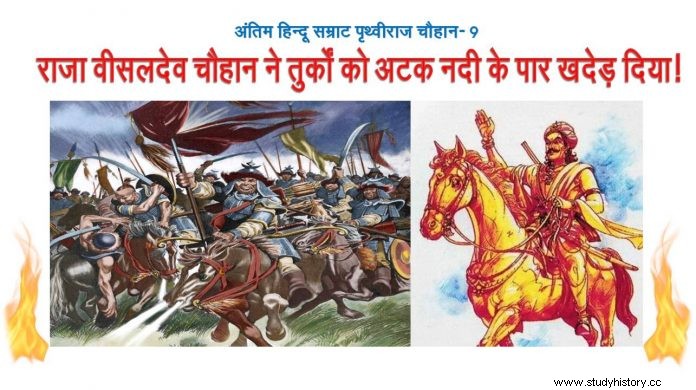
We had discussed in the previous episode that after the defeat of Chauhan king Arnoraj at the hands of Chaulukya ruler Kumarpal, Arnoraj re-collected his lost power and hoisted his victory flag to the regions of Sindhu and Saraswati, but his son Rajkumar Jagdev took the red flag of the state. He killed his father Arnoraj and himself sat on the throne of Ajmer.
In India the patrihanta king was not looked upon well and was removed by the princes of his own clan. The same thing happened with Raja Jagdev. Shortly after his accession to the throne, he was removed by his younger brother Vigraharaja (IV).
Vigraharaj (IV) has also been written as Bisaldev or Visaldev in many accounts. He remained the king of Ajmer till AD 1163. His rule is very important not only for the history of Ajmer but for the history of the whole of India.
Visaldev took Delhi and Hansi from the Tomars between AD 1155 to 1163. According to Nagari Pracharini magazine, Visaldev snatched Delhi from Tanwar Anangpal. This same Anangpal had installed a lot of iron on Vishnupad hill in Delhi, which has not rusted till date. This lat was installed as the flag of Vishnu. It is also called Keeli and it is located in Mehrauli village near Qutub Minar.
Prithviraj Raso has told that Anangpal's daughter Kamala was married to Someshwar, the Chauhan king of Ajmer and Prithviraj Chauhan was born from him, but according to other sources, Prithviraj's mother was Karpur Devi, the princess of Chedi country and not Tanwar princess Kamala.
Visaladeva fought heavy battles with the Chaulukyas and the Parmar kings under them and defeated them and snatched Nadol, Pali, Jalore and the surrounding areas from them. Visaldev burnt the city of Jalore to ashes to punish the Parmar feudatories of Jalore.
Watch this interesting history video-
He avenged his father's defeat by defeating Chaulukya Kumarapala.
Bisaldev also fought many wars with the Turks. At the time of Visaldev, an army of Turks came to the village of Vavvera. Visaldev defeated that army. After this, Visaladeva resolved that he would drive the Muslims out of Aryavarta. So he moved towards the north with a huge army.
A pillar inscription of Ashoka has been found from Delhi on which another inscription was engraved during the time of Visaladeva. This inscription is dated 9 April 1163 and it is called Shivalik Pillar inscription. According to this inscription, Visaladeva eliminated the Muslims from the country and instructed his successors to confine the Muslims to the other side of the river Attock.
The boundaries of the kingdom of Visaldev extended up to the Shivalik hills, Saharanpur and Uttar Pradesh. According to inscriptions, parts of Jaipur and Udaipur district were under his kingdom. There is no doubt that Vigraharaj, by his power and strength, suppressed the Mlechchas and made Aryavarta a truly Aryan land. The Muslim ruler Hammir, who is mentioned in the play Lalitvigraha, was Amir Khushrushah of Ghazni.
According to the Shivalik inscription, the boundaries of the kingdom of Visaldev ranged from the Himalayas to the Vindhyachal mountains. From this entire region he defeated the Muslim governors and drove them to the other side of Attock. The management fund describes him as the winner of the truce. During this period, Delhi remained the only thikana whose capital was Ajmer.
Vigraharaj (IV) i.e. Visaldev was the first Chauhan emperor of India and his nephew Prithviraj Chauhan was the last Chauhan emperor of India. Visaladeva's vast army consisted of one thousand elephants, one hundred thousand cavalry and even more number of foot soldiers.
Vigraharaj (IV) was a literary lover king and also a patron of litterateurs. People of his time called him Kavibandhav. He himself was the author of the play Harkeli. His court poet Somdev composed the famous historical drama Lalit Vigraharaj. In Ajmer, he built a Sanskrit school and Saraswati temple similar to that of Dhar, which is now left in the form of a two-and-a-half din ka Jhonpra.
A detailed inscription of 75 lines has been found from this school premises which declares that this school was built by Visaldev. Six fours of Harkeli Natak, written in Sanskrit by Vigraharaja, dated 22 November 1153, have been found from the Saraswati Kanthabharan temple complex.
An inscription of Vigraharaj (IV) kept in the Rajputana Museum declares that the Chauhan rulers are Suryavanshi Kshatriyas. He built the Vesalsar Lake in Ajmer in his name, in the middle of which he built the palace of his stay and many temples around it. He founded a town called Visalpur and built many forts. At the behest of Dharmaghosh Suri, he banned animal slaughter on Ekadashi.
During the time of Vigraharaj (IV), there was all-round progress of the Chauhan state. From the Himalayas to the Narmada, his name was taken with great respect. Dr. Dashrath Sharma has written about him that his importance is undeniable as he was a commander as well as a conqueror, patron of literature, a good poet and an intelligent builder.
The author of Prithviraj Vijay says that when Vigraharaja died, the title of Kavibandhava became meaningless because no one had the capacity to bear this title. Kielhorn also acknowledged his scholarship and wrote that he was one of those Hindu rulers who could compete with Kalidasa and Bhavabhuti. The time of Vigraharaj was the golden period of Sapadalaksha.
In the Narhad inscription of AD 1158, Parambhattaraka-Maharajadhiraj Parameshwara Shrimad is inscribed in front of the name of Vigraharaj (IV), and Devrajya behind the name. These titles were taken away from the Pratiharas by the Chauhans. It is also known from these titles that during this period Chauhan was the sovereign ruler of his vast empire.
Watch in the next episode- Prithviraj's father Someshwar gets the Chauhan's throne fortunately!
-Doctor. Mohanlal Gupta
